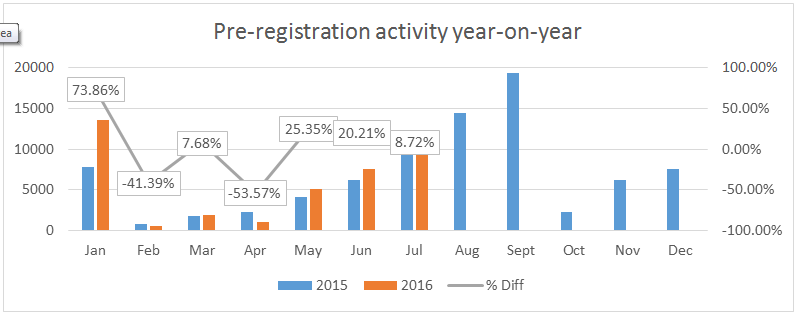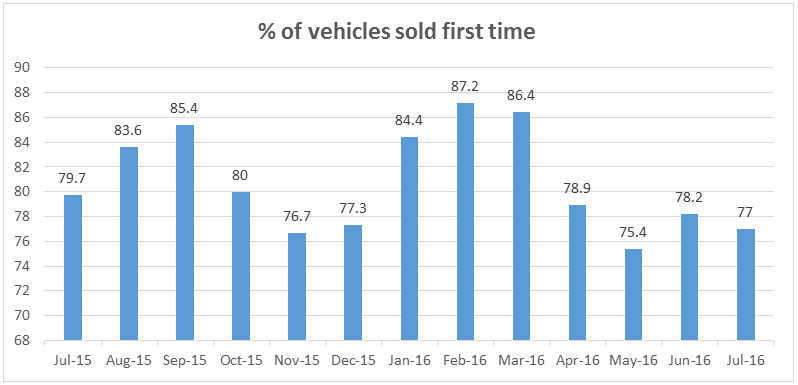The new car market will soon be firing on all cylinders.
The coming weeks will be a frantic scrabble to shift metal to the customer in the most efficient way possible, to meet both profit targets and volume commitments given to the manufacturers earlier in the year.
Market feedback in recent months shows that the retail consumer has been a little less prevalent on the forecourts and the Society of Motor Manufacturers and Traders’ data paints a mild slow-down in private vehicle registrations.
Whilst this downturn will change in September, in part due to pre-registration activity, warnings are already in place around the damage caused by tactical strategies.
The chart below from Glass’s data gives a high level view of the change in pre-registration position over the last 19 months.

The first thing to note is that the graph follows a pattern which is encouraging as it shows that nothing unexpected has happened in recent months and that the new car market has largely performed in the same way as 2015.
The pre-registration peaks form in January, when cars registered the previous September, are at their highest volume in the market, and also in September following the build-up of plates on sale from the March plate change.
However, the shift in pre-registration volume from January 2015 to January 2016 shows an increase of almost 74%, which is a sizeable uplift.
We can’t compare September data as yet but looking at the latest figures from data on the 16 plate change, pre-registration volume was 8.7% higher in July 2016 and a worrying 22.5% year to date.
With this level of increase there is little doubt that there will be downward pressure on all used values in coming months and manufacturers will need to consider the impact of any tactical push, both now and for the future.
Really interesting conclusions can be drawn from the insight gained when looking at both market sectors and specific manufacturer data at a more granular level by highlighting real market opportunity for greater penetration and resulting profit using Glass’s unique data.
Whilst pre-registration data gives a snapshot into the new car market the question is what is happening in the used car sector.
With plenty of conflicting views in the press, the data shows a far more consistent reality than many anecdotal conversations suggest.
With Glass’s industry contacts claiming a marked drop in retail footfall having a significantly detrimental effect on trade buying, and therefore used values, the chart below shows a less worrying picture.

Taking into consideration the fact that overall used car volume in July 2016 was down by 6.6% against the same period last year and acknowledging that there was a mild lull in activity in the three weeks leading up to the referendum, then the data in this chart does not depict a scenario of extreme concern.
Given that when market volume dips, vendors tend to hold out for the best value and, as such, may not sell their inventory on first entry, one might be forgiven for assuming the market is heading for a stock shortage and a resulting increase in values.
However, it is generally acknowledged that record registration volumes in recent years will see an increase in the number of cars in the market towards the end of the year and combined with pre-registration activity values will drop.
In summary, the evidence suggests that the new and used car markets have remained far more consistent than anticipated post Brexit.
Caution must be given to the fact that an element of the persistently strong registration activity will have been based on forward new car orders placed before the referendum but, despite comment to the contrary, we may yet see an uplift over the 2015 registration figure.
It is also important to remember that strategy and future plans must be based on fact focussed insight that considers comprehensive market data.
Whilst this editorial looks at high level information, it is vital to appreciate that greater review of different market sectors and varied vehicle ages will show variations in performance and deeper analysis will facilitate the identification of new and rewarding opportunities.
Author: Rupert Pontin (pictured), director of valuations, Glass’s




















Login to comment
Comments
No comments have been made yet.